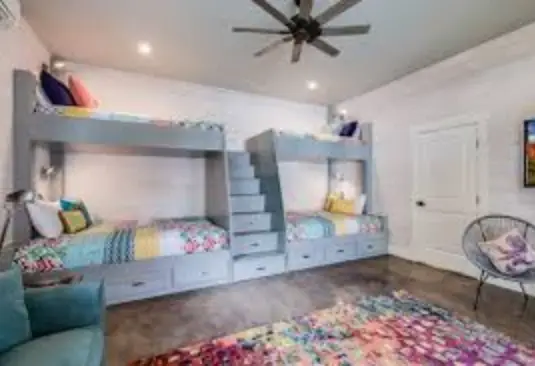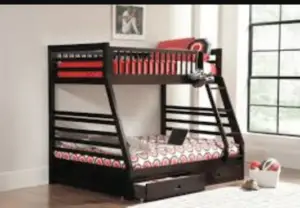
How to build framed bunk beds that kids will love in 2023
Making framed bunk beds for your kids and finishing with curtains increases the bach classic. Kids usually love them at home

You will need:
• 90mm x 45mm H1.2 framing timber (I used 30 lineal metres)
• 1 pack nails or screws
• Skillsaw
• Chisel
• 6 x joist hangers (optional)
• 5 x 12mm MDF sheets, plus a partial one to build the optional face for the trundler)
• Sandpaper
• Resene Quick Dry waterborne primer
• Resene Lustacryl semi-gloss waterborne enamel tinted to Resene Indian Ink
• Resene Colorwood in Resene Bark
• Resene EzyFill Quick
• 40mm x 40mm dressed pine (I used 3 x 1.8m lengths – one for each upright and the third for the step rungs on the ladder)
• Curtain rod
• Curtain (I used 6m corduroy)
• 4 large bolts and screws (8 gauge, 75mm)
• Trundler bed
• 18mm MDF sheet for optional front
• Finishing gun

How to make frame bunks for your children or kids:
1. Making a frame with the framing wood or timber by nailing it or screwing the frames together. By using screws, the bunk beds will be much easier to dismantle in the future. This frame was made to suit the ceiling height and to fit a king single mattress inside, allowing a bit extra for bedding. I fixed
the frames into the walls, floor and ceiling, making sure everything was level and plumb.
2. Add joists (the horizontal structure) to build a platform for the mattress. I used a skillsaw and chisel to notch the joists into the upright framework for strength. Alternatively, you could butt them in flush and fit the joist hangers. I only needed one level of joists because I put an existing bed and trundler at the bottom, but if you require two or three levels, simply repeat this step. Don’t forget to consider factors such as head height, access and safety when designing multiple level bunks.
3. Fit the platform for the bed. I used a 12mm sheet of MDF, but you could also use plywood. Fix this down to the joists using either short nails or screws.
4. Measure and cut MDF to encase all the framing timber. Try and have all the smooth faces towards the front of the bunks and the cut edges towards the back.
5. Before fixing the MDF to the framework, give everything a really good sand, then prime with Resene Quick Dry primer. I used Resene Indian Ink to paint two top coats.
6. Fix the MDF to the framework. I used a finishing gun or bradder. I made sure I numbered the back of each piece when I measured and cut it so I would know where it would go back on. Fill nail holes with Resene EzyFill Quick. Lightly sand and paint one more top coat to finish it off.
7. For the ladder, I used 40mm x 40mm dressed pine, notching in each of .the rungs like the joists. The ladder was painted with Resene Colorwood in Resene Bark and fixed to the end of the bunks with four large screws.
8. Provide privacy for your guests by adding curtains to create that enclosed feeling seen in old-style Scandinavian bunks. This look is cosy if you have multiple sets of bunks in one room. I hung the curtain rod on the inside of the framework and added corduroy curtains.
9. Create a front for the trundler, it’s an optional step but great if the bed is unsightly. Cut the face/cover for the front face of the trundler bed. I used 18mm MDF and fixed a border on it, then repeated the sanding, priming and painting process as described in Step 5.
10. Add handles, then drill four holes and use four bolts (as pictured) to fix the face piece to the metal frame.
Tip: Choose a waterborne enamel, such as Resene SpaceCote Low Sheen, for walls in high contact areas, such as this bunk bed. This will make it easier to wipe them clean later. You can also apply Resene SpaceCote Clear for extra protection.
More colours to try (left to right): Resene Indian Ink, Resene Rock Salt, Resene Spice.
Frequently Asked Questions
What is a good age for kids to have bunk beds?
Who should sleep on the top bunk?
How do you make a cozy bottom bunk?
Is a bunk bed safe for a 7 year old?
How much weight can top bunk hold?
Is it common for bunk beds to collapse?
Can wooden bunk beds collapse?
Is plywood strong enough for a bunk bed?
Which bunk beds are stronger metal or wood?
Do bunk beds need to be fixed to wall?

Can an 8 year old sleep in top bunk?
How far should a bunk bed be from the ceiling?
Can an 11 year old sleep on top bunk?
Why is the bottom bunk better?













Leave a Reply